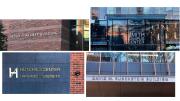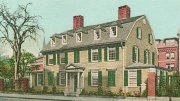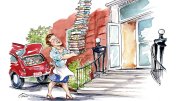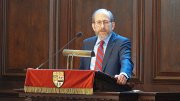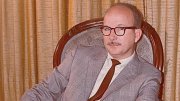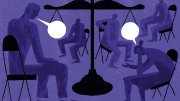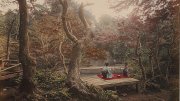A capital campaign often changes the look of a campus—especially Harvard’s current one, with its pronounced emphasis on bricks and mortar (and glass and steel and…), from undergraduate House renewal to the Business School’s Klarman Hall “convening center” (see “Klarman Construction”) and the (as-yet-unnamed) science and engineering complex across Western Avenue. New or renovated structures apart, the appearance of the place also changes as donors avail themselves of what development officers call “naming opportunities.” Shown above, a few refulgent reminders of this especially fruitful fundraising drive, writ large and meant to carry the memory of contemporary Harvard forward unto the many campaigns undoubtedly to come, “in the Age that is waiting before.”
Each spring, the University plunges into its Commencement rites: convincing proof that the place practices ritual at a very high level. Less often, it pulls out the stops to welcome a new leader. By the time you read this, the twenty-ninth Harvard president since 1636 may have been anointed, setting in motion the preparations for that other ritual, her or his installation. (For coverage of the announcement of Lawrence S. Bacow as twenty-ninth president on February 11, after this issue went to press, see harvardmag.com/bacow-18). Commencement has a regular director, whose office is in the suitably venerable Wadsworth House, just across the hall from that of Harvard’s Marshal: commandant for the May hoopla, and, typically, the organizer/officiant at other similar University extravaganzas freighted with symbolism and meaning. Whoever organizes the installation will likely consult the playbook for Drew Faust’s, in 2007; the fat binder is practically a foot thick.
The Game features football, of course, but its real attraction for many occasional fans of the sport is the opportunity to reengage with friends or acquaintances near familiar, hallowed grounds—as often those surrounding the Stadium or the Bowl, where the tailgating is first class, as the turf within. So it came as something of a surprise in November when Harvard Athletics and Fenway Sports Management announced that the 135th edition will take place at Fenway Park. Historic the home of the Boston Red Sox may be, but it is junior to the Stadium (1912 versus 1903), and in a dense urban setting not conducive to spreading out a picnic before (and during) the action on the gridiron. The Harvard Crimson editorially lamented “A Lapse in Tradition”—particularly for the fiftieth anniversary of the stunning 29-29 “Harvard Beats Yale” contest.
Happily, tradition will be served, no matter the venue. About the time that the site switcheroo became public, George Howe Colt ’76 delivered a manuscript with the working title The Game: Harvard, Yale, and 1968 to Scribner, about that game and the context of its times. The book will appear in October: the perfect thing for armchair fans, wherever they may find themselves this November 17.
From the memorial minute on Lee Rainwater, the late professor of sociology, presented to the Faculty of Arts and Sciences on December 5:
“His book Poor Kids in a Rich Country, co-authored with Timothy Smeeding…compare[d] the economic status of children in the United States to those in other rich countries. They found that children in the U.S. were far worse off and substantially more likely to be living in poverty…than their counterparts in other countries. Importantly, they showed that this was not primarily due to cross-national differences in demographics, such as the share of children in single-parent households or their ethnic or racial composition. Rather, it was a function of country-level public policies. In essence, the high levels of child poverty in the United States were the result of decisions made by American policymakers.”
